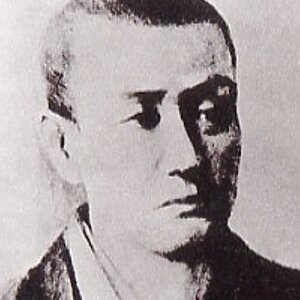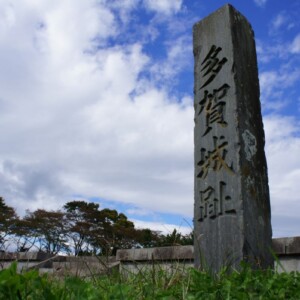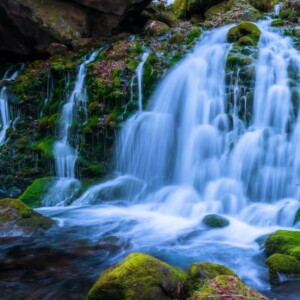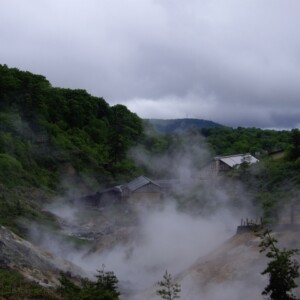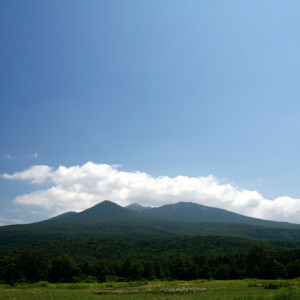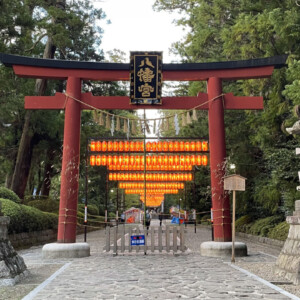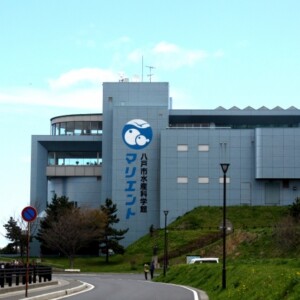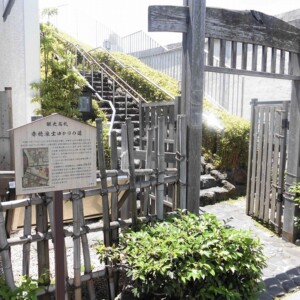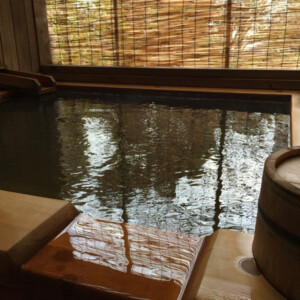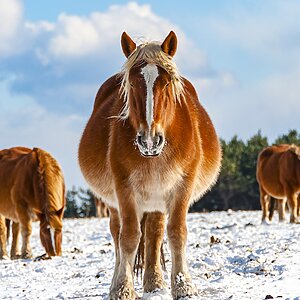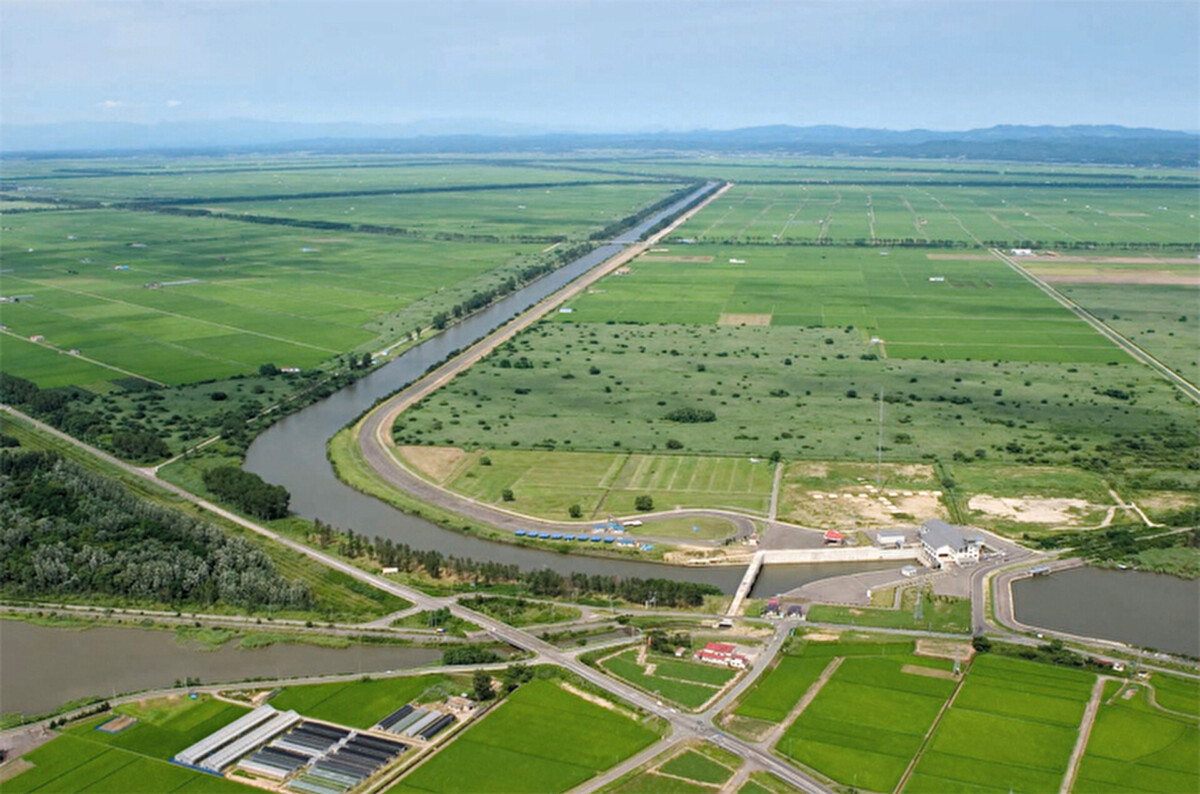
[History of Hachirogata reclamation ③] Earth lower than sea level... The lifeline is water management [Ogata Village, Akita Prefecture]
table of contents
- 1 Large pumps drain 700 million tons of water from reclaimed land surrounded by embankments
- 2 A tide gate was built on the Funakoshi Channel that connects Hachirogata and the open sea, cutting it off from the sea.
- 3 Drainage channel foundation work is progressing at the same time as the embankment is being constructed.
- 4 Ten months after drainage began, a dry-landing ceremony was held on the partially drained lakebed.
- 5 Agricultural water intake using the siphon principle
- 6 Western Waterway managed as an independent water body
- 7 A water access channel designed so that it does not matter if the sea level is different in the eastern and western parts.
- 8 The farmland area of Ogata Village is comparable to that of Kanagawa Prefecture.
- 9 Fishing industry has revived at Lake Hachiro
- 10 ``Ogata Village Reclamation Museum'' where you can learn about Hachirogata's past and present
On November 12, 1963, the 51.5km embankment was completed, and work to drain the water finally began.
The Hachirogata reclamation project aims to use 16,000 hectares (73%) of the water surface of the former Hachirogata, which was approximately 22,000 hectares, as land.First, the former Hachirogata will be surrounded by embankments to create a large island. The water inside the embankment is then drained outside, and the resulting lake bed is used for agricultural purposes.
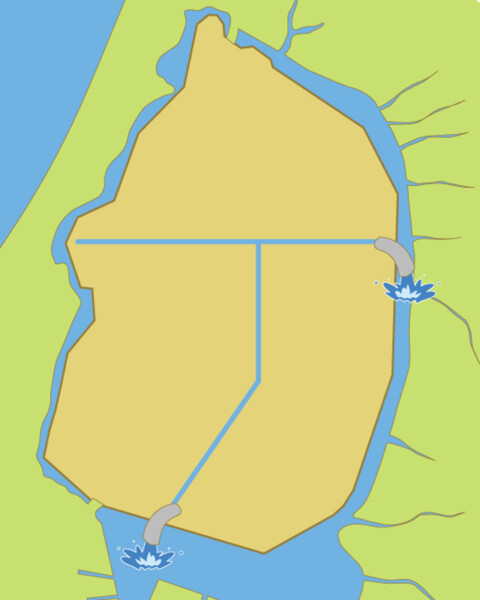
Large pumps drain 700 million tons of water from reclaimed land surrounded by embankments
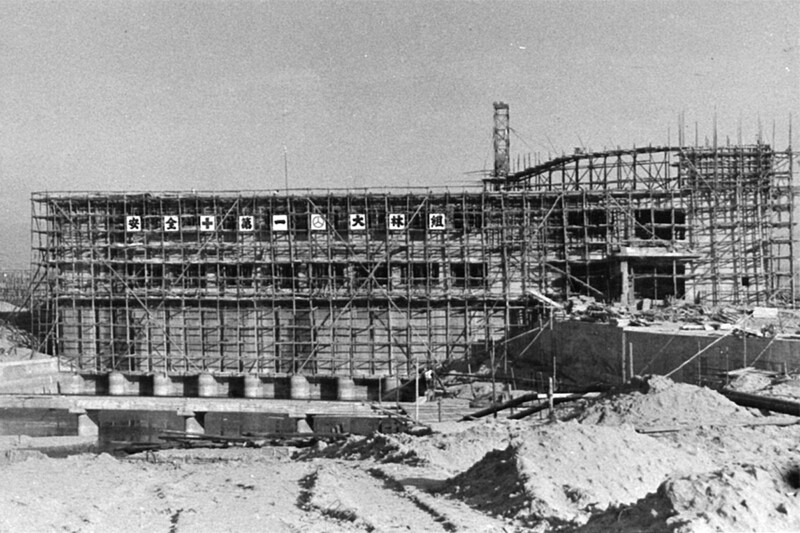
As a drainage method, a northern drainage pumping station was established to drain water into the eastern drainage canal on the east side of the reclaimed land, and a southern drainage pumping station was established to drain water into a regulating pond. Since we used several powerful drainage pumps to drain the water, we calculated that we could drain all the water in six months, but because we had to take various safety considerations into consideration, it took two and a half years to complete. The amount of wastewater discharged is said to be approximately 700 million tons.
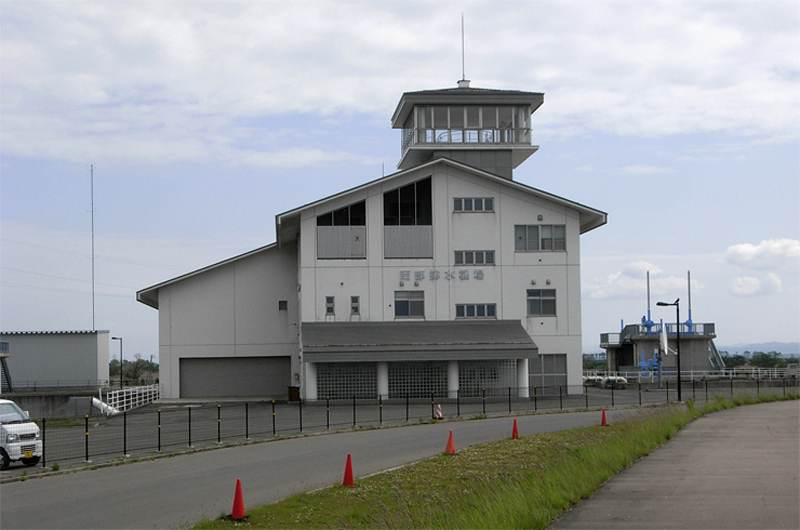
A tide gate was built on the Funakoshi Channel that connects Hachirogata and the open sea, cutting it off from the sea.
At the same time as the drainage work, work began to close off the opening that connected Hachiro Lagoon to the open sea. Hachirogata and Sotome were connected by a waterway called Funakoshi Suido, which was about 4km long. By constructing a tide gate on the Funakoshi Channel, it is possible to prevent the inflow of seawater as well as the rise and fall of the water surface due to the ebb and flow of the tide.
Ten tide gates were built, one of which was designed to allow vessels for reclamation work to pass through. In addition to the water gates, there are also lock gates for fishing boats fishing in the open sea or the regulating pond, and fish ladders for fish. A lock gate is a lock gate that, like the famous Panama Canal, has two locks that adjust the water level to allow ships to pass through when the water level is different at the entrance and exit.
Additionally, since reclaimed land is agricultural land, salt water cannot be used as agricultural water. Therefore, by stopping the inflow of seawater with a water gate, Lake Hachiro, the water source, can be turned into fresh water.
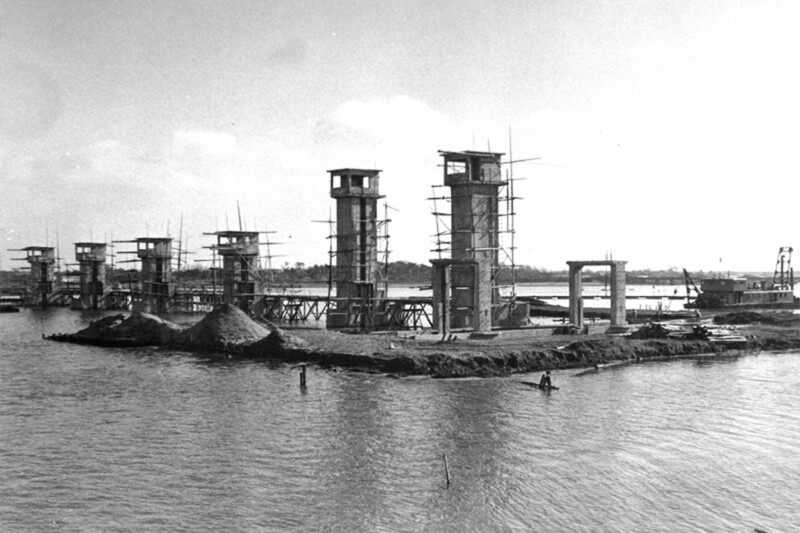
Since the beginning of the Heisei era, this flood gate has been renovated into a state-of-the-art facility, increasing the number of gates to 14, and is still in use today.
During the tide gate construction, the Funakoshi Channel, which had been meandering and had a low flow rate, was widened and straightened, and the riverbed was dredged (to remove sludge from the riverbed and deepen it).
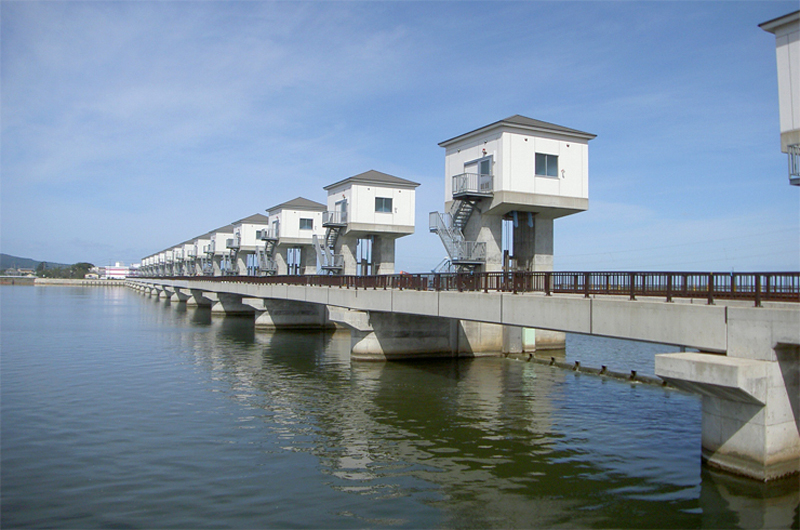
Drainage channel foundation work is progressing at the same time as the embankment is being constructed.
In polder reclamation, even after the entire polder has been drained, excess water such as rain, agricultural water, and domestic wastewater that accumulates inside the polder must be drained outside. Drainage is carried out from the drainage pump station, so it is necessary to construct a drainage channel within the reclaimed land to reach the drainage pump station. Drainage work had been carried out in a planned manner since the embankment construction was underway.
We dredged and used earth and sand from the lake bottom to build the embankment, but at the same time we designed the location of the drainage channel, used the dredger used for the embankment construction to dig a trench according to the blueprint, and completed the foundation work for the drainage channel. That's what I did. The earth and sand produced by dredging is used for construction of drainage canals.
After the drainage was almost completed, construction of the drainage channel began in earnest. A network of drainage channels with a total length of 600 km was constructed within the reclaimed land, but the construction of the drainage channels was quite difficult as the lake bottom was originally filled with soft sludge. This was overcome by the development of new excavation equipment that met the construction conditions, and the drainage network that still protects the reclaimed land was created.
Ten months after drainage began, a dry-landing ceremony was held on the partially drained lakebed.
Drainage work began in November 1963, and by the following year, September 1964, 6,500 hectares of lakebed had appeared. This area was about 35% of the reclaimed land, but it is said that 90% of the water was drained away. Although it has not yet completely become land, a grand government-sponsored drylanding ceremony is being held at this point. Ogata Village was also established in October.
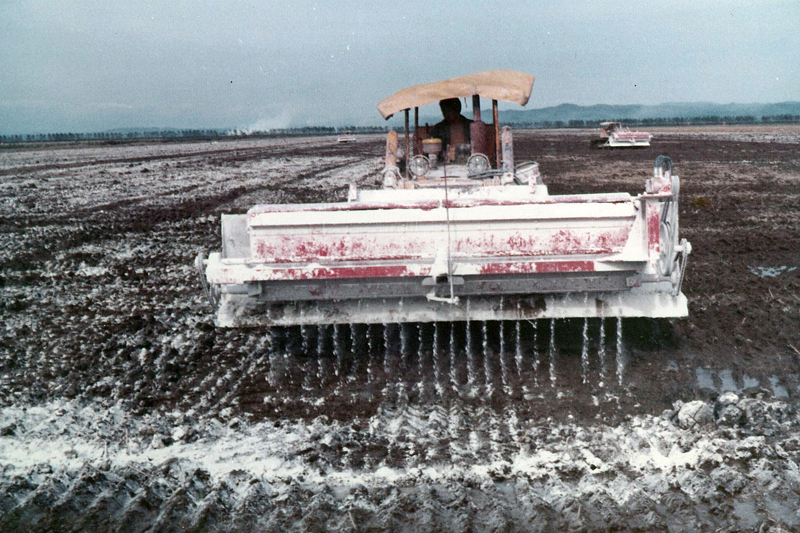
Hachirogata was a brackish lake, so the reclaimed land contains salt. If left as is, there is a risk of salt damage and it cannot be used as agricultural land. Moreover, the bottom of Hachirogata is sludge containing a lot of water. Sludge has strong acidic properties when dried, and many crops cannot grow if left untreated. It was necessary to improve the soil to a slightly acidic to neutral soil suitable for agricultural use.
Salt content is diluted by fresh agricultural water and rain. Acidification caused by drying sludge was counteracted by sprinkling alkaline lime.
Agricultural water intake using the siphon principle
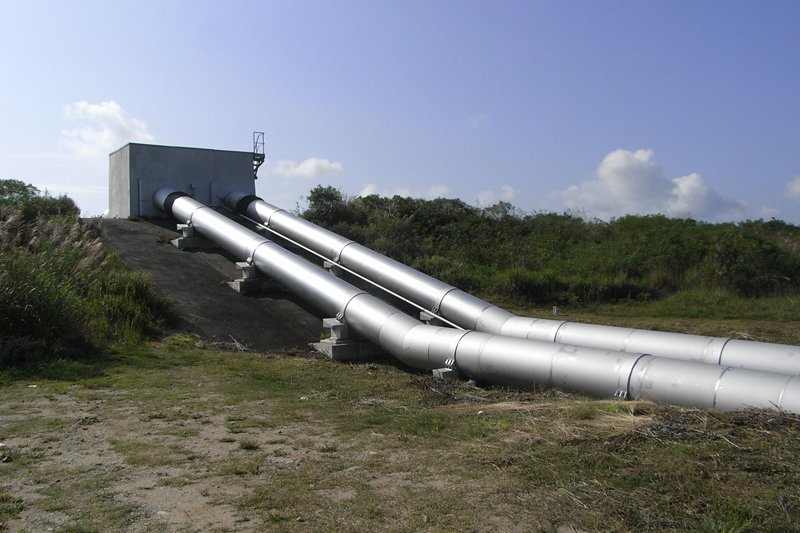
Since Hachiro Lagoon was reclaimed for agriculture, fresh water for agricultural purposes must be supplied after the land is drained. The reclaimed land is surrounded by a fresh water regulating pond and two receiving channels, so it was planned that water would be taken in from there. For this reason, 19 water intake facilities have been installed on the embankment surrounding the reclaimed land.
The Hachirogata embankment is built on soft sludge, so even though it has been reinforced, it would be a safety problem to run an intake pipe through the embankment itself. Intake pipes are installed across the embankment at some locations. This method was a very logical method, as it maintained the strength of the embankment and, in reclaimed land where the water surface was higher than the ground, could pump water without using power using the siphon principle. The embankment on the western side of the waterway was built on good ground, so a system was adopted in which intake pipes were passed through the embankment, and there were seven water intakes.
Western Waterway managed as an independent water body
Lake Hachiro consists of a large regulating pond in the south of the reclaimed land, an eastern channel on the east side, and a western channel on the west side. Water can freely flow in and out of the regulating pond and the eastern waterway, but the western waterway is separated from the eastern waterway in the north by a bank, and is connected to the eastern waterway by a thin earthen pipe underground. That's all. In addition, although there is a narrow waterway in the southern part of the pond, it is almost an independent body of water.
This structure dates back to the time of land reclamation and was designed with a purpose in mind. Lake Hachiro is a receiving lake for wastewater from reclaimed land, and at the same time is a source of water for agricultural use. A vast amount of agricultural water is needed to cover vast areas of reclaimed land, and without a source of fresh water, it would quickly dry up. Fortunately, there are nearly 20 rivers that flow into Lake Hachiro, which is equivalent to half the amount of water flowing into Lake Hachiro each year. However, the rivers flowing into the river are concentrated on the east bank, and there is none on the west bank.
A water access channel designed so that it does not matter if the sea level is different in the eastern and western parts.

Lake Hachiro has been adjusted to maintain the inside of the tide gates at an altitude of 35cm above sea level. Basically, the portion of river water that exceeds 35 cm is discharged from the tide gates through the Funakoshi Channel, which leads to the open sea. However, during the agricultural season when large amounts of water are needed, water must be stored in Lake Hachiro. Therefore, it was decided to raise the water level to 1m above sea level and supply a certain amount of water to the reclaimed land every day.
However, if the water level is raised to 1m above sea level, safety problems will arise unless embankments are built not only on the reclaimed side, but also on the opposite bank where there is no embankment. However, if we were to build an embankment on the opposite shore, it would require approximately 82km of embankment to go around Hachiro Lagoon. The materials, labor, time, and costs involved are enormous.
The river that flows into Lake Hachiro is only on the east bank, not on the west bank. Therefore, if we prevent water from flowing into the western entrance canal, the water in the western entrance canal will hardly increase naturally, and we can add water only when necessary. The water is immediately used for agricultural purposes, so the water surface remains low above sea level and there is no need for a dike on the opposite bank. Because building an embankment would be expensive, the Western Channel was purposely built as an independent structure.
There are currently four pumping stations that perform drainage, etc. The regulation pond has four drainage pumps and one "southern drainage pumping station" for regulating the western drainage canal, and the "northern drainage pumping station" with four drainage pumps and three "fangkou" pumps for the eastern drainage canal. (Kataguchi) Drainage Pump Station.” The "Hamaguchi Pump Station" (two pumps) is in operation on the Western Canal to adjust the water level.
The farmland area of Ogata Village is comparable to that of Kanagawa Prefecture.
The Hachiro Lagoon reclamation project started in 1957 and was completed in 1977, taking about 20 years to complete. Ogata Village's farmland, which was made from reclaimed land, now boasts an area comparable to the rice paddies in all of Kanagawa Prefecture.
- Ogata Village New Rural Construction Project (Hachirogata New Rural Construction Corporation)
- Farmland development 11,202ha
- Village land development: 687 ha of residential land development
- Disaster prevention forest 492ha
- Road within the residential area 19.3km
- Public facilities: Town halls, community centers, clinics, kindergartens, elementary schools, junior high schools, water supplies, sewers, garbage disposal sites, graveyards, streets, etc.
- Agricultural facilities: 580 farmhouses, 6 country elevators, 2 dry stores, 104 machinery hangars.
- Others Guidance and training for prospective settlers, farming guidance for settlers, purchase and transfer of farming machinery, etc.
- Source: Agriculture and Rural Development Information Center “Water and Soil Foundation”
Fishing industry has revived at Lake Hachiro
The reclamation of Hachirogata left a portion of the lake approximately 20% of the former Hachirogata. The remaining lake (Lake Hachiro) has changed from brackish water mixed with seawater to fresh water, but after the reclamation project was completed, some fishing activities were restored. The catch has decreased from around 1,900 tons before reclamation to about 250 tons, but about 170 people still continue to fish, mainly fishing for smelt.
``Ogata Village Reclamation Museum'' where you can learn about Hachirogata's past and present
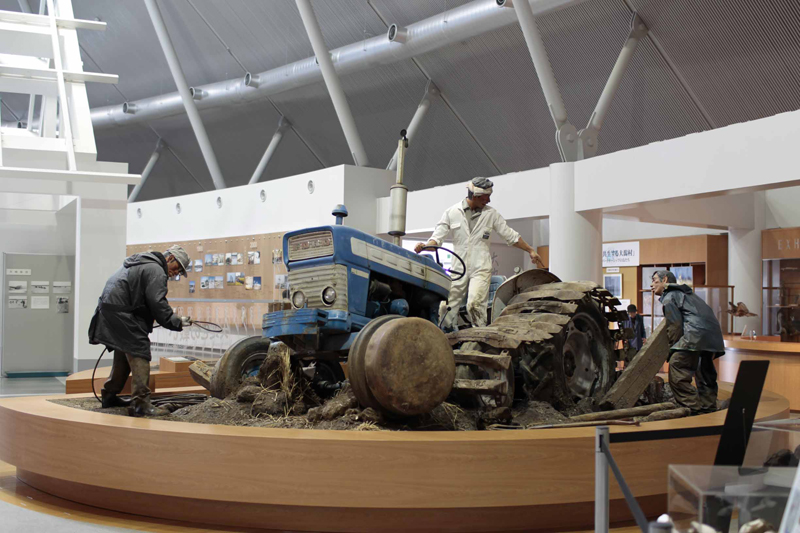
This museum was established to preserve for future generations the footprints of the historic project that reclaimed Hachiro Lagoon, which was the second largest lagoon in Japan. We have collected materials such as the history and significance of Hachirogata reclamation, the existence of Ogata village, and reclamation techniques, and are exhibiting them in videos and panels.
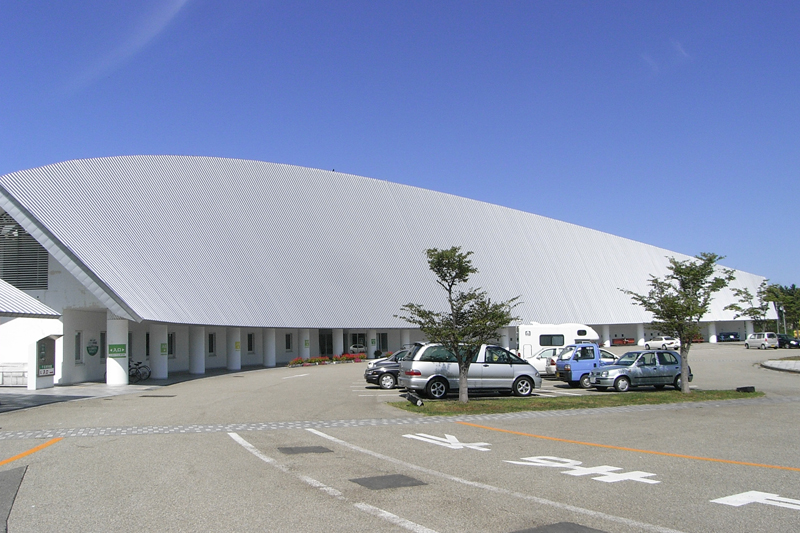
Ogata Village Reclamation Museum<Information>
- Facility name: Ogata Village Reclamation Museum
- Location: 5-2 Nishi, Ogata Village, Minamiakita District, Akita Prefecture
- Phone number: 0185-22-4113
- Opening hours: 9:00-16:30 (*Admission until 16:00)
- closing day
- April to September: 2nd and 4th Tuesday
- October to March: Tuesdays, New Year holidays (December 31st to January 3rd)
- *If Tuesday is a holiday, the following day will be closed.
- Admission fee: 300 yen for general public and university students, 100 yen for elementary, junior high and high school students,
- *Free admission for customers with a disability certificate/rehabilitation certificate, including accompanying persons.
- URL: Ogata Village Reclamation Museum
- access
- Public transportation: Approximately 20 minutes by taxi from Hachirogata Station on the JR Ou Main Line
- Car: Approximately 15 minutes from Kotooka Moritake IC on the Akita Expressway
Google Map
Ogata Village<Information>
Ogata village
- Location: Ogata Village, Minamiakita District, Akita City
- Phone number: 0185-45-2111
reference
- Ogata Village Encyclopedia
- Oga Peninsula/Ogata Village Geopark
- Akita Net, the land of beauty
- Agriculture and Rural Development Information Center “Foundation of Water and Soil”





![[Hirogata reclamation history ①] The second largest lake in Japan has become a vast rice field [Ogata Village, Akita Prefecture] 7561d23df2a0ec24c664e184c3fc8d8f](https://jp.neft.asia/wp-content/uploads/2024/07/7561d23df2a0ec24c664e184c3fc8d8f-150x150.jpg)
![Hachirogata, once the second largest lake in Japan [Akita Prefecture] Ogata Village | Hachirogata Reservoir Pond](https://jp.neft.asia/wp-content/uploads/2017/03/24094900_m-150x150.jpg)
![[Iwate Prefecture] Soft-serve ice cream with sake, miso and wasabi flavor! Why are the soft serve ice cream eaten at roadside stations so delicious? There's also school lunches! Iwate Prefecture Catch](https://jp.neft.asia/wp-content/uploads/2025/06/915fd0ce722ab0f21e74864401170847-150x150.jpg)
![[Yamagata Prefecture] Let's go try the delicious, locally produced soft serve ice cream at Yamagata's roadside station! Yamagata Catch](https://jp.neft.asia/wp-content/uploads/2025/07/2c2e7024e6ed08990103582514a5844e-150x150.jpg)
![[Iwate Prefecture] A unique soft serve ice cream near Morioka City! Why are the soft serve ice cream eaten at roadside stations so delicious? Morioka 4](https://jp.neft.asia/wp-content/uploads/2025/05/189a4a932dca375175b5cc49cd9a6d53-150x150.jpg)
![[Akita Prefecture] Akita has more than just Babahera ice cream! 5 roadside station soft serve ice creams with a wide variety! Showa 7](https://jp.neft.asia/wp-content/uploads/2025/07/635663812d6465cd23ff69f727cb14a8-150x150.jpg)
![[Iwate Prefecture] Japanese-flavored soft serve ice cream from the southern part of the Sanriku coast! Why are the soft serve ice cream eaten at roadside stations so delicious? IMG_0050](https://jp.neft.asia/wp-content/uploads/2025/06/IMG_0050-150x150.jpg)
![[Akita Prefecture] Part 2 of Akita Roadside Station Soft Cream! 4 Popular Soft Creams in the Prefecture's Inland Rice-Growing Region! Akita 2 Catch](https://jp.neft.asia/wp-content/uploads/2025/08/bf9fa170ebe4e828628e72952707b851-1-150x150.jpg)
